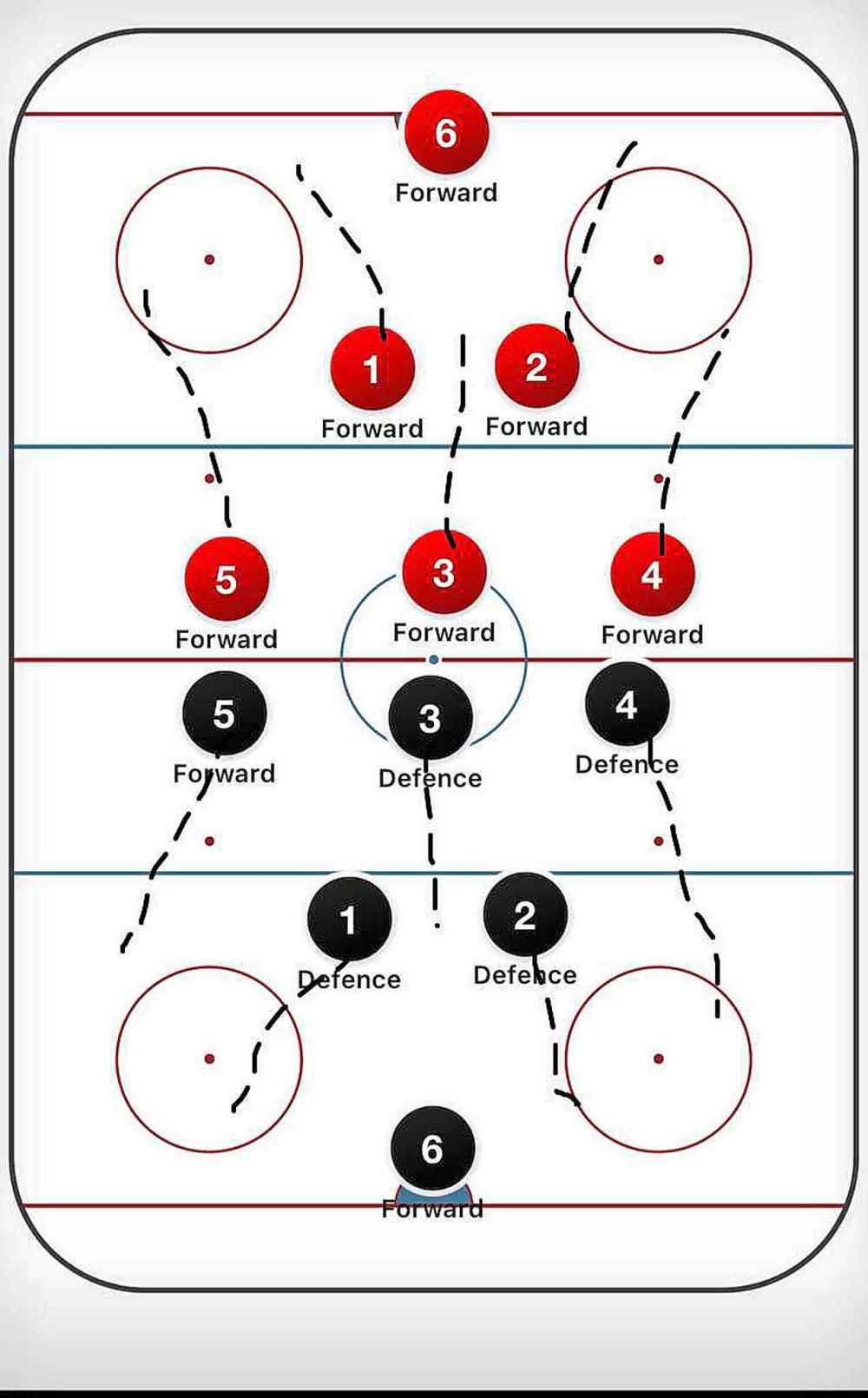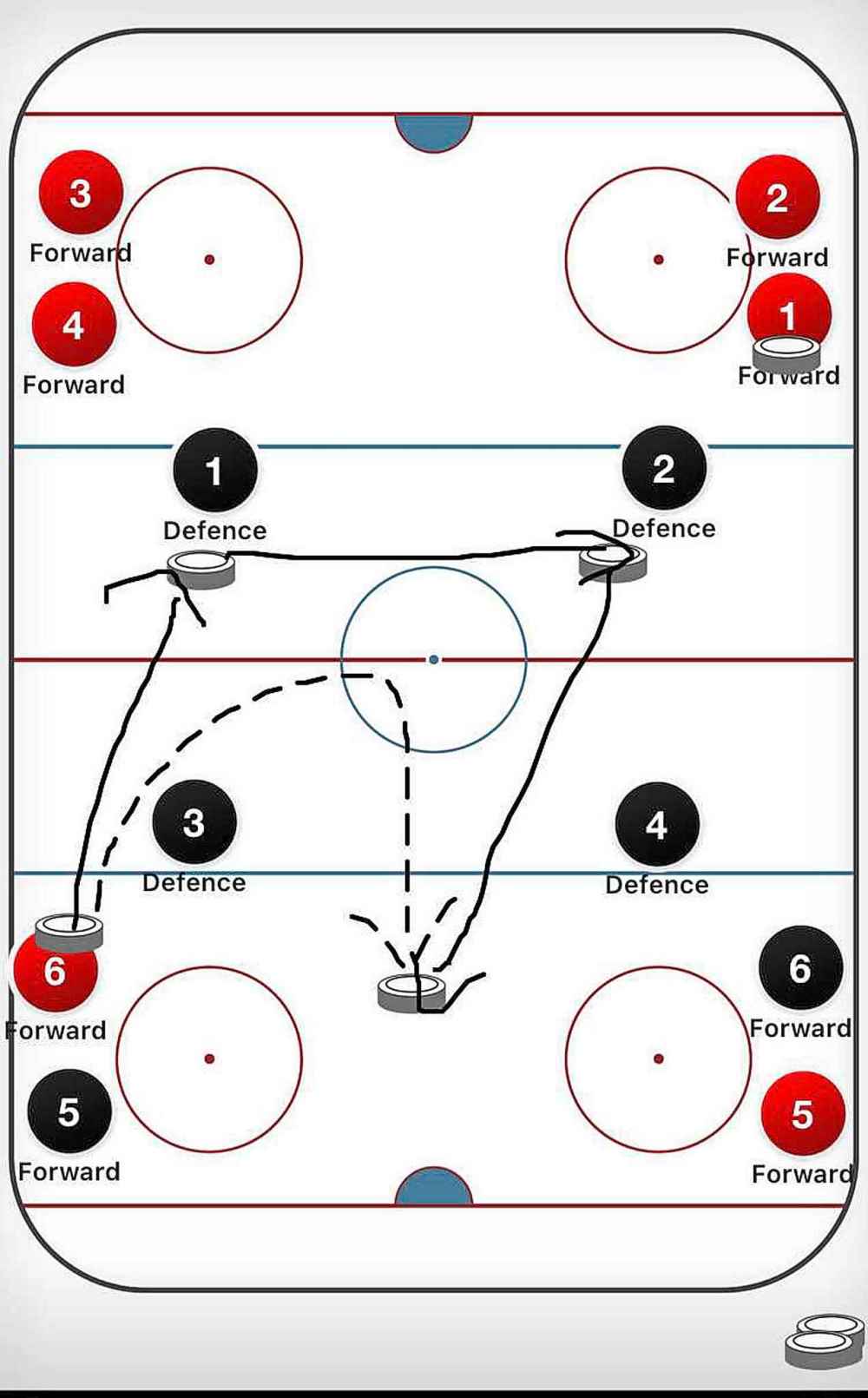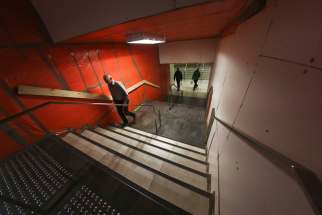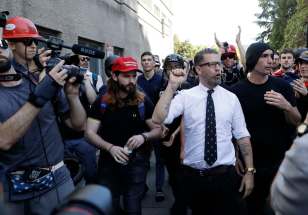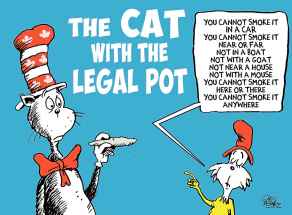Skill-sharpening machine NHL practice — even after a disheartening home loss — mixes precise purpose-specific drills, one-on-one tutoring and a helping of fun
Read this article for free:
or
Already have an account? Log in here »
To continue reading, please subscribe:
Monthly Digital Subscription
$0 for the first 4 weeks*
- Enjoy unlimited reading on winnipegfreepress.com
- Read the E-Edition, our digital replica newspaper
- Access News Break, our award-winning app
- Play interactive puzzles
*No charge for 4 weeks then price increases to the regular rate of $19.00 plus GST every four weeks. Offer available to new and qualified returning subscribers only. Cancel any time.
Monthly Digital Subscription
$4.75/week*
- Enjoy unlimited reading on winnipegfreepress.com
- Read the E-Edition, our digital replica newspaper
- Access News Break, our award-winning app
- Play interactive puzzles
*Billed as $19 plus GST every four weeks. Cancel any time.
To continue reading, please subscribe:
Add Free Press access to your Brandon Sun subscription for only an additional
$1 for the first 4 weeks*
*Your next subscription payment will increase by $1.00 and you will be charged $16.99 plus GST for four weeks. After four weeks, your payment will increase to $23.99 plus GST every four weeks.
Read unlimited articles for free today:
or
Already have an account? Log in here »
Hey there, time traveller!
This article was published 19/10/2018 (2612 days ago), so information in it may no longer be current.
It is a mantra of many successful organizations: practise like you want to play. The line of thinking is based on the belief that good habits developed when essentially nothing is on the line will prove fruitful down the road when the stakes are at their highest.
And while there are plenty of eyeballs on the Winnipeg Jets every time they lace up their skates for a game, the majority of fans don’t get to see what goes down every time they gather to be put through their paces by coach Paul Maurice and his staff.
Are they skating laps? Around pylons? With or without pucks? Scrimmaging? Horsing around?
With some of those questions in mind, we invite you to gather ’round the figurative whiteboard today as we take you inside a typical Jets practice and break down some of the Xs and Os.
Whether you’re a minor-hockey coach yourself, a parent of a young player or simply a fan of the game, you may be surprised to learn there’s a method to the monotony. Every drill has a specific purpose, and we suspect some are going to look familiar to you.
Just remember to stretch and drink plenty of fluids to avoid cramping up!
***
“Anyone could do the drills we’re doing,” assistant coach Todd Woodcroft told the Free Press this week as he sat down to explain just how much goes into planning an NHL practice.
Woodcroft said the coaches have about 60 different drills they’ll run in a given season. They typically get together a couple of hours before a practice to decide on the handful they’re going to run that day.
Assistant coach Jamie Kompon is considered the master planner, but everyone on the staff has input. Goalie coach Wade Flaherty’s views are especially important; keeping the masked men feeling good is a high priority.
“He sees it through that goalie lens,” said Woodcroft.

Several factors will be considered, including the club’s schedule, whether they have a full group and their next opponent. For example, the Washington Capitals are a team that love to use the cross-seam pass to burn opponents. So Woodcroft said the Jets will tailor drills in advance of such a game just to get everyone in the mindset.
Same goes with plenty of battle drills when they expect a rugged game, such as any time they meet a Central Division opponent.
“Paul has an incredible recall of things that have happened in the past, drills that we’ve done. He’ll be like, ‘Remember last November before the Montreal game, we did this drill?’ I barely even remember playing Montreal last November,” said Woodcroft.
There is rarely a pure skating drill, especially once the season gets going. Conditioning skates are usually done only during pre-season.
Woodcroft said that’s a big change from when he first broke into the league 18 years ago as a video coach with the Minnesota Wild. No longer are early season practices needed to get guys in shape. They’re already coming to camp in elite condition, likely having spent much of the off-season working out with personal trainers and coaches.
“Now it’s all about maintenance,” said Woodcroft. And making sure everyone feels right for the games.
The most important thing isn’t which particular drills they’re doing, but how they’re doing them.
“It’s all about pace and intensity,” Woodcroft said, adding captain Blake Wheeler leads by example and plays a huge role in getting players to buy in.
“I’ve never seen (another) player like Blake and the way he drives in practice,” he said. “Blake will never be upset if you pass the park too hard. But give him a muffin where he has to put his head down to look around and get it and you’ll hear about it.”
•••
It’s the morning after Tuesday’s crushing overtime loss to the Edmonton Oilers and spirits are surprisingly high.
All 23 skaters on the roster are present as Maurice kicks off the noon skate in traditional fashion with everyone gathering in the centre-ice circle. He’s joined by assistants Kompon, Woodcroft, Flaherty and Charlie Huddy.
After a quick pep talk the team is essentially split into two groups, one in each end of the rink. The first drill is one of the most basics, a staple of almost every practice and morning skate.
Groups of five — a full forward line and a defence pair — retreat into their own end to retrieve a puck that’s been dumped in by one of the coaches. There is no forecheck, no pressure. The objective is simply for one of the blue-liners to retrieve it, then break it out to either his partner or one of the forwards. As soon as they exit their zone, the puck is sent back to the coach and the process repeats itself.
Both ends are being used at the same time, so there is constant motion, even if it’s being done at what seems like half-speed.
Woodcroft said this is simply about “getting touches” on the puck, which is an important way to start things off. Get everyone feeling good, get the feet moving.
This goes on for only about three minutes before Maurice blasts his whistle.
•••
Now it’s time for the goalies to get warmed up. The second drill of the day involves four defencemen posted at the two blue lines, essentially making a square. The rest of the skaters are broken into four groups, on both sides and both ends of the rink.
They will do three different variations of this drill over the next five minutes. But it essentially involves skaters individually passing the puck to one of the defenceman and then getting it back in some fashion.
First, the puck goes D-to-D before coming back. Then it’s turned into a give-and-go with the original passer, eventually becoming a full cross-ice feed where defenceman are hitting the skater from the other end. In every case, it ends with a shot on either Connor Hellebuyck or Laurent Brossoit.
A skater from each end is going at the same time. It’s a bit of well-organized chaos.
Players are strategically shooting at the netminders, hitting their gloves and blockers and pads and stick. This is no time for fancy dekes or head-hunting shots.
•••
The third drill is designed to get the pace up and build chemistry between forwards. The seven defencemen on the roster are parked near centre ice along the boards, while the four regular forward lines are stationed along the boards near the blue line, using both sides and both ends.
It begins with two forwards in the north end getting a breakout pass from the stationary defenceman. Picking up speed, they bear down on a defenceman who is waiting near centre and beginning to retreat into the south end. They go in two-on one and continue until they either score or the play is broken up.
Then the process repeats itself, with two new forwards now breaking out of the south end with help from that defenceman to go in on another defenceman who’s gotten himself into position in the north end. Rinse and repeat.
After about five minutes, the drill is expanded to a full 3-on-2 and it begins to resemble a wide-open game with back-and-forth rushes.
•••
The intensity has clearly picked up. And that’s evident in the fourth drill of the day, which is meant to simulate game action.
A full forward line begins near centre, with a pair of defenceman parked on each blue line. The two wingers head into the north end with a single puck and take an uncontested shot on goal. The centre is right behind them, and he joins them as they turn around now to head south, followed by two defencemen in their end, making it a 5-on-2.
But it’s about to turn into a 5-on-3, as Woodcroft is standing with another forward he will “release” to become a backchecker. That forward’s job, along with the two defencemen standing on the south end blue line, is to try to defend against the rush and clear the zone as quickly as possible.
About five minutes pass before Maurice blows his whistle. He’s not happy. The coach clearly doesn’t like the speed at which the drill is being done, and there are a few too many missed passes and bobbled pucks for his liking. Maurice lets his troops know, in no uncertain terms.
Once they return, things look a little crisper. It continues for about 10 more minutes.
•••
The fifth, and final, drill of the day is all about 5-on-5 play. One group on the attack, the other defending.
Using just the north end of the rink, it begins with the defensive forward line all together to the right of the goalie. One of the defending blue-liners is near the front of the net, while his partner is to the left of the goalie near the faceoff circle. He’s joined side-by-side by one of the attacking forwards. The two other attacking forwards and two attacking defencemen are near the blue line.
A coach fires a puck behind the net, and the defending blue-liner and attacking forward near the faceoff dot race to see who can get it first and gain possession. On a whistle, they have to make an explosive burst to the top of the circle, then change directions and go behind the net for the loose biscuit.
Once one of them gets it, the battle is on. The attacking group is trying to score, cycling the puck and working the points. The defending group is trying to clear the zone. If they do it too quickly, the coaches send another puck back in to keep things going.
This is where Maurice is most animated. He can be heard repeatedly yelling “move, move, move,” and “get out, get out, get out,” while also praising smart puck decisions by bellowing “that’s a good call.”
Goals are hard to come by, but there’s a huge cheer when Joe Morrow’s shot is tipped by Andrew Copp at one point to beat Hellebuyck. This activity lasts about 12 minutes total.
The whistle goes to signal the formal end of practice. Total time is about 40 minutes. Now the real fun begins.
***
Maurice and Wheeler take a knee at centre ice and have a chat that lasts several minutes. Dustin Byfuglien is working with Huddy in one end, taking one-timers from his coach. Flaherty, the goalie guru, is in discussion with Hellebuyck, his star student.
Rookie Brendan Lemieux is getting some pointers from Kompon. Woodcroft grabs a stack of pucks and heads to a faceoff circle with centre Jack Roslovic for some extra practice in the dot. Adam Lowry comes over after a few minutes to watch and give some friendly advice.
“That was a specific part of Jack’s game we wanted to work on. Adam came over and that’s an area he’s really strong at,” Woodcroft said.
Flaherty eventually moves on to Brossoit, who’s getting in some extra movement work, sliding side-to-side.
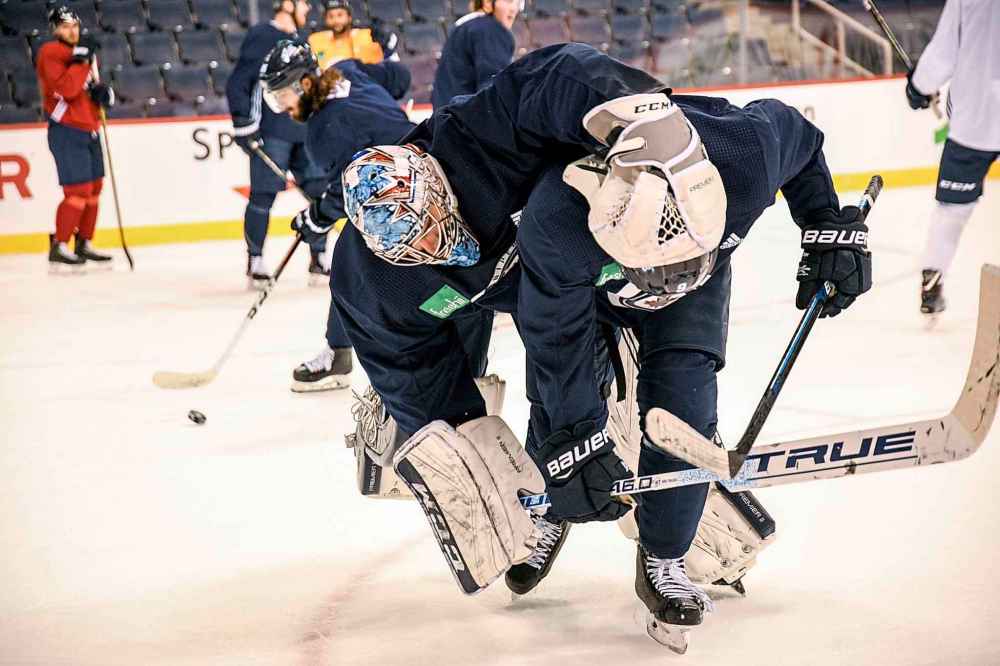
Mathieu Perreault grabs a pair of sticks and places them in the corners of one of the nets, creating a pyramid shape. There’s now a tiny window of space above each stick in each corner of the net which players are going to try and pick.
For close to 15 minutes, about a dozen Jets are engaged in some kind of contest. There may be more at stake than just pride: perhaps a future dinner tab?
There’s also plenty of trash-talking, with Lemieux leading the way as it came down to the final three: Roslovic, Nikolaj Ehlers and Brandon Tanev.
“That’s a former AHL All-Star right there, boys,” Lemieux said when Roslovic was eliminated with a missed shot.
Ehlers came up clutch, firing the winner through the opening, touching off a huge celebration, one the struggling forward no doubt hoped he could soon replicate in a real game.
•••
Woodcroft said it’s important to keep things loose to help get through the rigours of a long regular season.
“We are lucky to be able to come to the rink every day and earn a living playing a game,” he said.
In meeting with the media after practice, Maurice sounded proud of his pupils.
“I liked the way things went a lot today on the ice. They pushed real hard in some drills, but there’s absolutely no reason for any of us to every overlook the fact that a day in the NHL is a pretty good day. I want them to bring that to the rink,” he said.

“There were parts of our practice that were as good today as they’ve been as good all year in some of the hard parts, so I want that, want that really focused work on the ice.
“And then I want to see a smile on their faces while they’re doing it, I want to see some joy in the grind. That’s what we’re searching for here a little bit.”
•••
Jets coaches met with about 75 minor-hockey coaches last Saturday following practice, part of a Hockey Manitoba seminar. Woodcroft said it was a valuable experience for all, with Jets staff being reminded of just how strong the grassroots level of the sport is.
Woodcroft said his advice to minor coaches of any level is to plan ahead. Get players to stretch before you hit the ice. Go through practice drills with your team in the dressing room so things get going immediately. Give certain drills fun names so that players will instantly know them.
“Ice is very expensive. You want to make sure you’re maximizing it,” he said.
And, most importantly, reinforce good habits while trying to ensure bad ones don’t creep in.
“Practice like you want to play,” said Woodcroft.
mike.mcintyre@freepress.mb.ca
Twitter: @mikemcintyrewpg

Mike McIntyre grew up wanting to be a professional wrestler. But when that dream fizzled, he put all his brawn into becoming a professional writer.
Our newsroom depends on a growing audience of readers to power our journalism. If you are not a paid reader, please consider becoming a subscriber.
Our newsroom depends on its audience of readers to power our journalism. Thank you for your support.

